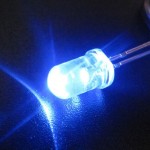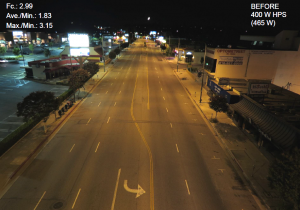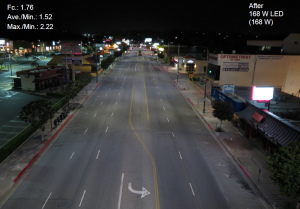Are LEDs good for dark skies?
Unfortunately, no… they could be, but as they are presently being used, they almost never are. Not even close.
[slideshow_deploy id=’2229′]
[slideshow_deploy id=’2229′]
| Sky glow increase from a high-pressure sodium to LED conversion. (For the much more dramatic increase with an LPS to LED conversion, see here) |
But how can that be?
In recent years the press and the U.S. Department of Energy are effusive about the revolution in lighting being brought about by LEDs. In remarks in a press release announcing the 2014 Nobel Prize in physics (awarded to researchers who invented the blue LED that underlies the ultra-bright white LEDs) Nobelprize.org states:
 New light to illuminate the world
New light to illuminate the world
This year’s Nobel Laureates are rewarded for having invented a new energy-efficient and environment-friendly light source – the blue light-emitting diode (LED). In the spirit of Alfred Nobel the Prize rewards an invention of greatest benefit to mankind; using blue LEDs, white light can be created in a new way. With the advent of LED lamps we now have more long-lasting and more efficient alternatives to older light sources.
And in their announcement of the Prize, the International Dark-Sky Association notes:
If we light properly we can use LEDs to save energy, improve visibility, and lower light pollution levels.
The DOE, power companies and other governmental agencies have provided substantial financial assistance to communities in replacing current roadway lighting with LED. A typical high-profile example is Los Angeles, which has replaced over 140,000 high-pressure sodium streetlights with LED. The Los Angeles Bureau of Street Lighting reports that energy use has been reduced over 60%, saving $7.5 million per year; maintenance costs are predicted to fall by $2.5 million per year.
| Los Angeles, Ventura Blvd | |
 |
 |
| Before retrofit | After retrofit |
So – the buzz is that LEDs promise not only huge energy savings but also reduced light pollution. How can we claim otherwise?
Looking closely at the facts and numbers, a different story emerges. Regarding energy savings the story is not as simple – and not as dramatic – as described (see below). Regarding light pollution the conclusions are clear, and not positive.
LEDs and Light Pollution
For sky glow light pollution, the conclusion is unambiguous: research shows that white light – of any kind (CCT) – has substantially greater impact on sky glow than yellow light (see our page Lamp Spectrum and Light Pollution). Compared to the currently prevalent high-pressure sodium lights, even the lowest-impact white LEDs (though higher-impact LEDs are far more widely used) will increase visible sky glow lumen-for-lumen 2.2x – more than double. Compared to PCA LED the increase is over 3x, and compared to the most night-friendly light, low-pressure sodium or NBA LED, the increase is 6x. This is not 6% nor even 60% – it is 6x or 500%! The most optimistic predictions for decreased lighting amounts that might be achieved with LEDs (due to better optical control) cannot compensate for this.
We examine two LED street lighting retrofit projects below. The first – Los Angeles, California – replaced HPS with 4000 K CCT white LED, and with modest illumination reductions. The LA example is typical of most LED retrofits.
The second example – Tucson, Arizona – replaced a mixture of HPS and LPS with 3000 K CCT white LED. Total lumen amounts and average illumination levels were more aggressively reduced. The Tucson example shows about the best that can be done without using amber LEDs, and as far as we know the magnitude of the Tucson lumen reduction has not been matched in any other community.
The Los Angeles LED Retrofit and Dark Skies
In the Los Angeles retrofit, the LEDs used (4000K CCT) cause, lumen-for-lumen, about 2.7x (or 170%) more sky glow than the HPS lighting they replaced. Even when total lumen amounts are reduced proportional to the illuminance reduction seen on Ventura Blvd (41%1 – see figures on the images above), the retrofit has still increased sky glow from streetlighting by about 60%2. And in a fair equal-illuminance comparison, the LED system has about 170% greater impact. Again, more than double.
1 The needed lighting level, and no more, should always be used – with any lighting technology. It is hard to understand why LA had Ventura Blvd illuminated to 3.99 fc, as that level is higher than any professional lighting recommendation.
2 (The actual sky glow changes will be smaller due to “dilution” by the other lighting in Los Angeles, which was not changed. See the discussion below under the Tucson retrofit.
The Tucson LED Retrofit and Dark Skies
In the Tucson retrofit, the LEDs used are 3000 K CCT, which cause lumen-for-lumen about 2.1x (or 110%) more visual sky glow than HPS, but 5.4x (or 440%) more than LPS. But here the total amount of installed “fixture” lumens was reduced from 481 mega lumens to 179 mega lumens3 – a 63% reduction. Taking both the “step backward” effect of the spectrum change and the “step forward” lumen reduction, we estimate the visual sky glow arising from street lighting only in Tucson has been decreased by 21%. Due to the dilution effect of the other urban lighting that has not been changed, we estimate that this translates to an actual overall visual sky brightness reduction of 5%. (An attempt to measure this change is reported in Barentine et al., 2018 – but given its small magnitude it is unsurprising that definitive results were not obtained.)
While this is an improvement (though it would be visually imperceptible to most people), by choosing white LED (even if 3000 K CCT), Tucson has forgone the possibility of an overall sky glow reduction more than 3X as great – 18% – if they had used a good PCA LED. If they had used good NBA LED, matching the beneficial spectral characteristics of their former LPS lighting, the reduction would have been 21%. If Tucson was willing to reduce illumination levels to this extent, it is hard to understand why they would sacrifice their previous amber lighting standards and thus leave substantial benefits on the table.
We don’t want to diminish what Tucson has accomplished – in the world of white LED retrofits, they are an unprecedented example. But they have degraded their amber lighting standards and missed an opportunity for a substantial improvement in their night skies. This degradation of the formerly world-leading Tucson amber lighting standards will mean that other lighting users, including the tremendous number of LED retrofit projects that are ongoing, will now likely follow the lead of the City and go to low-CCT white LED. These other users, accounting together for a much greater lighting amount than on roadways, will be much less likely to pursue significant lumen reductions. It is hard to see how Tucson skies will not continue to degrade, even without growth in the city and concomitant growth in lighting amounts.
3 The needed lighting level, and no more, should always be used – with any lighting technology.
LEDs and energy savings
Though LEDs offer opportunities for modest energy savings, it appears in many of the most-publicized examples energy savings arise primarily because lighting levels are being reduced. In the example above on LA’s Ventura Blvd, average illuminance was reduced from 2.99 to 1.76 fc – a 41% reduction. That’s a real energy benefit, but most of it comes from reduced lighting levels (available using any light type!), not from increased energy efficiency of LEDs. If LA had reduced light levels 41% while retaining HPS lamps (or PCA LED with an HPS-like spectrum), they would have reduced energy use but also reduced sky glow from the streetlighting by 41%, instead of increasing it 60%.
This is not a characteristic of just the LA retrofit, either. An analysis by Kostic et al. and published 2013 in Lighting Research and Technology concludes:
The average energy savings when using LED instead of high-pressure sodium (HPS) luminaires amount to 19–26% for single-sided, staggered and opposite layouts, although they are frequently negligible if mesopic effects are not included. The total costs of the LED lighting solutions, even including mesopic effects, are 1.36 to 6.44 times higher than those of the comparable HPS lighting solutions. Therefore, LEDs are questionable for street and roadway lighting.
Tucson has demonstrated a more aggressive approach, but still left significant benefits on the table by switching to white LED instead of an amber LED, and Tucson had more to lose due to their now abandoned amber lighting standards.
So the conclusions are clear – switching to white LEDs from the current yellow light technologies using sodium lamps saves only a little energy, much less than is being touted, unless lighting is dramatically reduced. But sky glow light pollution in the vast majority of retrofits is dramatically increasing.
How could LEDs help dark skies?
- First and foremost, use yellow LEDs (not low-CCT white LEDs)! NBA LED with a spectrum similar to LPS (0.4x the sky glow impact of HPS), or PCA LED with a spectrum similar to HPS (0.7-1.6x the impact of HPS) should be used, or at worst filtered warm-white LEDs (1.5x the impact of HPS). These are not the most efficient LEDs at present, but can be a good tradeoff to balance energy and dark sky impacts.
- Take advantage of LED dimming technologies to dim or turn off lights when activity or traffic levels justify it.
…And for any light type:
- Only light roadways when a full assessment of costs (both fiscal and environmental) and benefits, including fiscal, environmental, and safety, shows overall benefits.
- Always use fully shielded fixtures.
- Use the lowest illumination level possible.
Come to FDSC for the best in dark skies information and recommendations!
